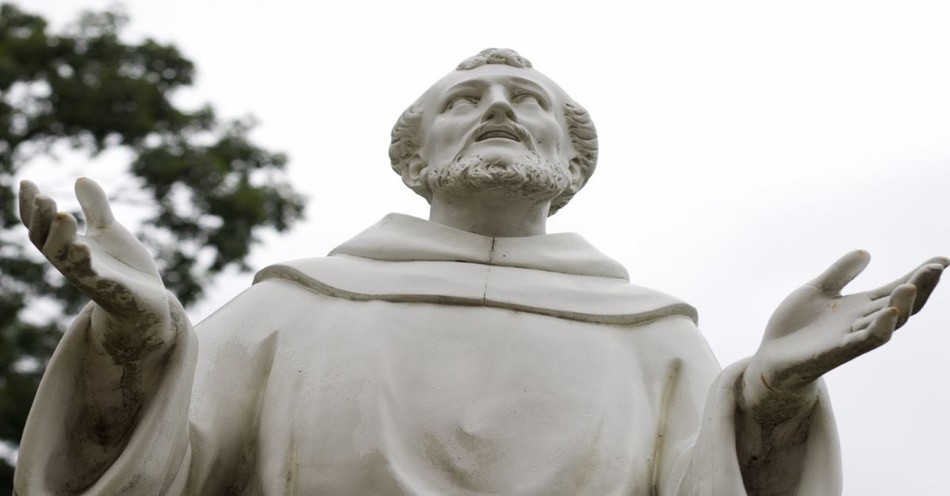Origin of the Prayer of St. Francis
This prayer was first recorded in 1912 in France, in a spiritual magazine called La Clochette (The Little Bell). The magazine was published by a Catholic group called The Holy Mass League. The group was established by Father Esther Bouquerel in 1901.
In the version published in La Clochette, the prayer was entitled, in French, “A Beautiful Prayer to Say During the Mass”. Since it was published anonymously, the original author is not known. Possibly, Father Bouquerel himself could have written the prayer.
Eventually, in 1915, the prayer was sent to Pope Benedict XV, still written in its original French. A year later, in 1916, it appeared in the daily newspaper of the Vatican, and it was then written in Italian. Later on, around 1920, a French Franciscan priest printed the prayer on the back of the image of St. Francis of Assisi. It bore the title “Prayer for Peace” in French. At this time, though, it was not attributed to St. Francis yet. The first time it was attributed to him was in 1927, by a French Protestant group called “The Knights of the Prince of Peace”.
Between the two world wars, the prayer made its way to Europe, eventually being translated into English. The first known English translation appeared in a book entitled “Living Courageously” written by Kirby Page. He also attributed the prayer to St. Francis of Assisi.
During and after the Second World War, the prayer for peace was spread all over, and it was already known as the Prayer of St. Francis. The most widespread use of the prayer was through the books of Cardinal Francis Joseph Spellman, who was then Archbishop of New York.
Over the years, the Prayer of St. Francis became more and more popular worldwide. Later on, not just Catholics but people of all faiths began adopting the prayer.
The Prayer of St. Francis
Lord, make me an instrument of your peace
Where there is hatred, let me sow love
Where there is an injury, pardon
Where there is doubt, faith
Where there is despair, hope
Where there is darkness, light
And where there is sadness, joy
O Divine Master, grant that I may
Not so much seek to be consoled as to console
To be understood, as to understand
To be loved, as to love
For it is in giving that we receive
And it's in pardoning that we are pardoned
And it is in dying that we are born to Eternal Life
Amen.
Meaning of the Prayer of St. Francis
The first line of the prayer is asking for the Lord’s help for us to spread peace to the people around us. It was Christ’s mission to bring God’s perfect state of peace to the world during His earthly ministry. St. Francis saw this as his mission as well. In his Rule of 1223, he writes, “they should not be quarrelsome or take part in disputes with words…or criticize others; but they should be gentle, peaceful and unassuming, courteous and humble, speaking respectfully to everyone… Whatever house they enter, they should first say, ‘Peace to this house.’”
A large part of loving peace is eschewing hatred. In his 9th Admonition, called Charity, St. Francis pens these words: “Our Lord says in the Gospel, Love your enemies. A man really loves his enemy when he is not offended by the injury done to himself, but for love of God feels burning sorrow for the sin his enemy has brought on his own soul and proves his love in a practical way.” Hence the line, “Where there is hatred, let me sow love.”
In the midst of the chaos of the Crusades, St. Francis found a path of non-violence. He went to Egypt in search of the leader of the Muslim forces called the Sultan. Once they met, St. Francis had a peaceful dialogue with the Sultan. A spirit of understanding, respect, and forgiveness dominated their conversation. Thus goes the line, “Where there is an injury, pardon.”
As a young man, there was a time when St. Francis found himself in serious doubt as to whether God really cared for him. As he prayed in solitude, God opened his eyes of faith. He then saw a vision: Christ Himself was gazing at him from the cross, but with such loving eyes that his soul melted. This lifted his doubt away. The line “Where there is doubt, faith” can inspire others to see beyond their doubts as well.
St. Francis also took great care of a lot of suffering people in his time. Thanks to his help, these desperate people felt dignified with a ray of hope upon experiencing such compassion. The lines “Where there is despair, hope” and “Where there is darkness, light” express the desire to give hope to the otherwise hopeless.
Because of St. Francis’ belief in God, he had a reason to always be joyful. God overflowing with love was his source of joy. Sometimes, he would even take two sticks, tuck one under his chin, and move the other stick over the one under his chin as if he were playing the violin. Then he would sing songs of praise in French. That was how joyful St. Francis was in the presence of God. He even said that he wanted his followers to go around and “inspire the hearts of people and stir them to spiritual joy.” The line “And where there is sadness, joy” serves to stir people’s hearts in hopefully the same way.
The last seven lines describe the heart of the Gospels. They also serve as a good set of guidelines to live by every single day. It’s about giving than receiving, and it emphasizes the sacrificial nature of the love of Christ, which we also ought to show to others.
Using the Prayer of St. Francis Today
The prayer of St. Francis is a prayer loaded with spiritual meaning. For one, the words of the first few lines indicate how we should live our lives. In this world full of darkness, despair, and sorrow, we should be people who promote light, hope, and joy. This prayer is all about living our lives just as Jesus did during His time here on Earth. Living in a similar way is the most effective way of reflecting the image of God through our lives as His creation.
Although Francis of Assisi did not actually write this prayer, he was known to faithfully live out the principles in it. Though born to a wealthy family, he chose to dedicate his life to Jesus Christ later on. It is said that he even had a vision where Christ told him to “repair my church,” and so he did with his own hands. He chose to live a life pleasing to Christ, even if it meant leaving his material wealth behind.
For many of us, we may not be called to the same path as St. Francis. However, as followers of Jesus, we are all called to be like Him and to live as He did. Whether we have plenty or few, landlord or peasant, CEO or laborer, this prayer reminds us of how we ought to behave every day, especially in the way we treat others.
This article is part of Christianity.com's prayer answers including famous, topical prayers and information about the power of prayer. Find more related articles in the collection of prayers below:
The Serenity Prayer
The Lord's Prayer
Morning Prayers
Prayers for Healing
Thanksgiving Prayers
Advent Prayers
Christmas Prayers
Prayers for Peace
Prayers for Protection
Prayers for Strength
Praying in the Spirit
This article is part of our prayer resources meant to inspire and encourage your prayer life when you face uncertain times. Remember, the Holy Spirit intercedes for us, and God knows your heart even if you can't find the words to pray.
Prayers for Healing
Morning Prayers
Prayers for Family
Prayers for Surgery
Prayers for Strength
Night Prayers Before Bed
Prayers for Protection
The Lord's Prayer: Our Father




